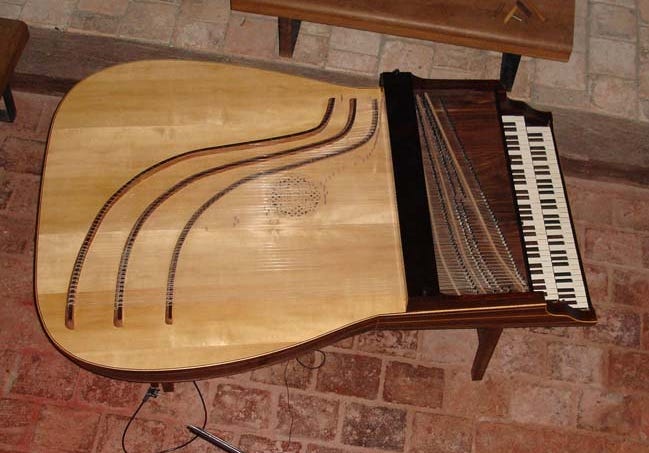May 23: Lute and Keyboard Works (Evan Shinners, piano & lute-harpsichord (sort of))
"You are not playing Bach – Bach is playing you."
Piano hero Brad Mehldau just released his album After Bach II, a second volume of Bach preludes sandwiched between improvisations on Bach’s themes. This music is bespoke tailored to my sensibilities. Ten stars, go listen to it.
The liner notes are trenchant. Here’s Brad countering critics who complain that certain Bach performances are too personal, and somehow don’t channel Platonic Bach:
With Bach, the more you try to engage with him, the more your own personality becomes visible, unavoidably. You are not playing Bach – Bach is playing you, in the sense that he lays you bare. Musicians love Bach in a different way than other composers, because he feeds them. You learn about yourself: as a striver-towards-beauty, as an intellect, and not in the least, as a problem-solver, because of the demands of the counterpoint. What you choose to emphasize or forgo at any given moment says much about you, even, in a fashion, in a “moral” sense – as to what your own musical values are, and why. You are called to examine yourself.
I think he’s implying, too, that through this self exploration, Bach can bring you closer to God.
Today I’m writing about the keyboardist Evan Shinners’ three new records which kick off his decade-long megaproject of recording Bach’s complete keyboard works. These albums are deeply personal, variegated, and idiosyncratic — per Brad’s dictum, only Evan could have put out these recordings, and that’s a great thing. We get to learn more about Bach and about Evan, and through our reactions to both, more about ourselves.
(Full disclosure: I attended the record release concert in New York last week at Evan’s invitation. And as a member of the press, no less — I haven’t been one of those since 2000, when I had a bi-weekly op-ed in the Rutgers Daily Targum entitled, “Fine Tuned”, thank you very much.)
These three volumes are in reverse order of listener accessibility. The first is a collection of Bach’s early pieces performed on a historically accurate, mean-tempered keyboard. It often sounds plainly out of tune to modern ears. (YouTube, Spotify, Apple Music.)
Certain passages are like a ripe fruit with a slightly unusual flavor, as in the Gigue from BWV 832:
Other moments are more disorienting. Here’s the middle bit of the Allemande from BWV 832. We start off okay, but we’re drifting real weird by 0:09:
It’s a bold way to begin a ten year project! The pianism is excellent, and the dissonances became less strange the more I listened, but I’m still not at ease with the tuning.
The second volume is played on a lute-keyboard, sort of. Shinners and his engineers took digital samples of notes from an 18th century lautenwerk, then coded an upright piano to play those samples as its keys are depressed. The sampled plucks resonate through the contemporary piano’s strings and wood. (YouTube, Spotify, Apple Music.)

So we’re listening to the lute suites “as they were originally composed,” except through two digital mediations. These lute suites are among my most favorite all-time compositions, and it’s cool to hear them in a wider tonal range than I’m used to in the traditional adaptations for guitar. Here’s a little clip from the concert:
The third album is a smorgasbord of preludes and fugues performed on a standard modern piano, with many pieces new to me. This is the most straightforwardly accessible and enjoyable record of the three. (YouTube, Spotify, Apple Music.)
Throughout the three albums, we hear Shinners’ unwavering dedication to extreme articulation. Every note is loud and clear, even when played softly. He has much to tell us about Bach, and about himself, in the most welcome way.
Many highlights below. (We’re covering BWV 820, 821, 822, 832, 833, 870, 895, 899, 900, 901, 902, 902A, 921, 933-38, 943, 947, 949, 952, 953, 959, 961, 997, 998, Deest.)
We’re lucky to listen to Bach today, because we have pianists who can look in the rear view mirror and also see Chopin. Here’s a thrilling bisected opening to BWV 921:
The fanfare from the prelude of BWV 870a is here to remind you that everything in the world is good:
In the fugue that follows, a series of people join to celebrate good news together. Happy music through and through:
Keith Jarrett wrote a beautiful song called, “Everything That Lives Laments.” The Sarabande of the C Minor Lute Suite BWV 997 could share the title:
The Gigue in the next movement I know well from Segovia. This tune sometimes arrives to me unbidden, and I’ll sing along as my brain plays the tape. I have an understanding family:
True to the nature of the Complete Recorded Works, Evan’s recorded some of the works Bach left unfinished. Bach is so much about a sense of flow — the abrupt ending of BWV 938 is a major coitus interruptus:
BWV 902a is like a lost Goldberg Variation — my ears are getting better, I heard this and thought ‘Goldbergs’ without knowing 902a was also in G Major.
I’ll conclude with a few clips from the great Lute Suite in E flat Major BWV 998. The prelude drips with beautiful melodies. Here’s the last minute of it:
But the suite’s emotional heart is in the following fugue:
Good wishes to Mr. Shinners on the next (50?) volumes of his project.






Shinners’ interpretation is like a swim in a river of Bach rather than a mathematician’s thought palace of Bach. I like it immensely.
Thank you so much for this. I can't wait to dive in, and follow along.